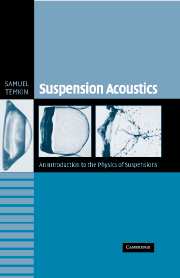Book contents
- Frontmatter
- Contents
- List of Figures and Tables
- Preface
- 1 Preliminaries
- 2 Conservation Equations
- 3 Rigid-Particle Heat Transfer at Re ≪ 1
- 4 Translational Motion at Re ≪ 1
- 5 Shape Deformations
- 6 Volume Pulsations
- 7 Thermodynamics of Suspensions
- 8 The Two-Phase Model
- 9 Sound Propagation in Suspensions
- 10 Applications and Extensions
- Appendix A Material and Transport Properties of Some Substances at 1 atm and 20°C
- Appendix B Useful Formulas from Vector Analysis
- Appendix C Explicit Expressions for Some Quantities in Spherical Polar Coordinates
- Appendix D Some Properties of the Spherical Bessel Functions
- Appendix E Legendre Polynomials
- Bibliography
- Author Index
- Subject Index
- Symbol Index
4 - Translational Motion at Re ≪ 1
Published online by Cambridge University Press: 25 August 2009
- Frontmatter
- Contents
- List of Figures and Tables
- Preface
- 1 Preliminaries
- 2 Conservation Equations
- 3 Rigid-Particle Heat Transfer at Re ≪ 1
- 4 Translational Motion at Re ≪ 1
- 5 Shape Deformations
- 6 Volume Pulsations
- 7 Thermodynamics of Suspensions
- 8 The Two-Phase Model
- 9 Sound Propagation in Suspensions
- 10 Applications and Extensions
- Appendix A Material and Transport Properties of Some Substances at 1 atm and 20°C
- Appendix B Useful Formulas from Vector Analysis
- Appendix C Explicit Expressions for Some Quantities in Spherical Polar Coordinates
- Appendix D Some Properties of the Spherical Bessel Functions
- Appendix E Legendre Polynomials
- Bibliography
- Author Index
- Subject Index
- Symbol Index
Summary
Introduction
We now turn our attention to the first, and most basic, of the motions that very small particles can exhibit: uniform translation. When the Reynolds number is very small, this motion may be studied without taking into account other motions that the particle may also be executing (e.g., small-amplitude volume pulsations). This means that all that the particles may be regarded as rigid so far as the translational motion is concerned. Thus, the velocity of a particle undergoing translations may be obtained from Newton's second law once the forces on the particle are prescribed.
Thus, the focus of this chapter is the particle force, that is the force with which the external fluid acts on a small, rigid particle. This force plays a central role in suspension dynamics and is considered here in some detail for the limiting case when the Reynolds number is very small. The chapter also contains some information on the forces that act on a particle at finite. Rotating particles are also mentioned briefly.
Basic Equations
In order to obtain the fluid force acting on a uniformly translating suspension particle, it is generally necessary to solve the equations of fluid dynamics with suitable conditions at the surface of the particle (i.e., with moving boundary conditions). Such a problem cannot yet be solved analytically for arbitrary motions or particle shapes. Fortunately, certain simplifications are possible.
- Type
- Chapter
- Information
- Suspension AcousticsAn Introduction to the Physics of Suspensions, pp. 61 - 129Publisher: Cambridge University PressPrint publication year: 2005



